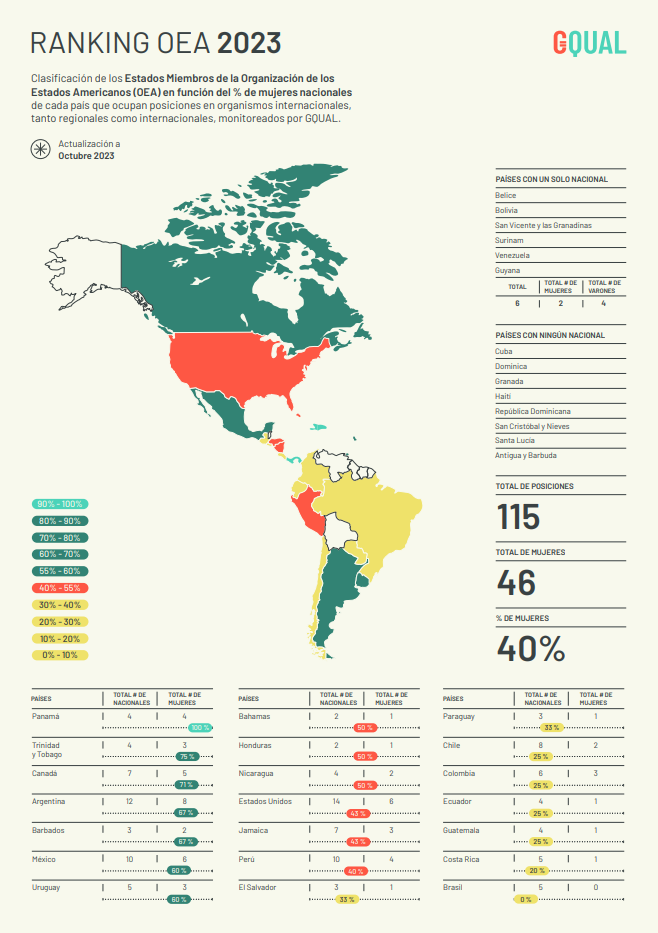LAUNCHING THE GQUAL RANKINGS 2023
We at GQUAL believe that data production is essential to understanding the picture of women’s representation in international justice–and how to change it. Data helps us make the invisible visible, identify which questions we should be asking, and what new information we need to gather, disaggregate and analyze. Data is necessary for diagnosing and understanding challenges, devising and implementing necessary measures, and monitoring their effectiveness.
We are very excited to share the following newly updated GQUAL Rankings (as of October 2023):

The GQUAL Rankings tracks data from countries that have nationals serving in international positions monitored by the Campaign, and disaggregates them by gender and geographical representation. Furthermore, the three rankings provide information valuable to identifying trends in both the nomination practices of States and of different Regional Groups, as well as in their representation records.
What do the 2023 Rankings tell us?
- In 2023, we began monitoring 15 new human rights mechanisms–making for a total of 103. These include the Commissions of Inquiry, Fact-Finding Missions and Other Investigations, and the Expert Mechanisms of the UN Human Rights Council. The vast majority of these bodies are generally composed of three members, ensuring an equitable gender distribution. As of October 2023, out of a total of 623 people holding positions in the international bodies monitored by GQUAL, 268 (43%) are women (a compared to 41.68% in September 2022). This increase is partly due to the fact that the new mechanisms monitored this year are bound by rules on gender balance in their composition.
- Women’s representation in the different UN Regional Groups has slightly increased, reaching 43% (compared to 40.48% in September 2022). The average number of women in each Regional Group occupying seats in these spaces is 53.6. The Asia and the Pacific States Regional Group continues to feature the highest representation of women, with a total of 59 (or 47.58%).
- The representation of women among the OAS countries remained the same as last year, at 40%.
The GQUAL Rankings provide a global and regional overview of women’s representation in international bodies at the present time. Having gender-disaggregated data is a key component of our work for gender parity in these spaces. In order to #ChangeThePicture, and in order for women to be able to effectively exercise their right to equal participation and representation in international decision-making spaces, we need to know where women are–and are not–represented. We also need to know other information that is inaccessible today–which would allow us to better understand how diverse the group of people occupying international positions is in reality.
As Liliana Ronconi pointed out in her commentary to the GQUAL’s 2022 Rankings, “the existence of data such as the one presented here allows us to have tools to analyze the behaviors of the States when nominating candidates in a comparative way over time. Thus, the production and dissemination of data such as the GQUAL Ranking will result in having key information to influence state policies when selecting or supporting certain candidates.”
Some notes to keep in mind:
- Only those countries with more than one national elected to international positions are included in the #GQUALRankings
- The #GQUALRankings include only persons elected to positions in international bodies. In other words, the ranking does not reflect nominations that may have been promoted by States but did not result in elected positions.
- The #GQUALRankings showcase that, as of October 2023, a total of 623 persons occupy positions in international bodies. However, not all of these positions depend on State nominations. This is the case of the Special Procedures (Special Rapporteurships and Working Groups) of the UN Human Rights Council, for which candidates can apply directly, without the need for a State nomination.
We invite you to explore and share the three Rankings.
- The GQUAL Global Ranking reflects the % of women holding positions in the 103 international bodies monitored by GQUAL as of October 2023.

- The Regional Ranking groups the countries according to the % of women in international positions monitored by GQUAL, divided into the 5 UN Regional Groups.

- The OAS Ranking classifies the Member States of the Organization of American States (OAS) according to the % of women nationals of each country who hold positions in international bodies, both regional and international, monitored by GQUAL. The infographic highlights countries that have more than one national elected to international positions, but also identifies those countries that have only one national or none at the time of updating the Ranking.

